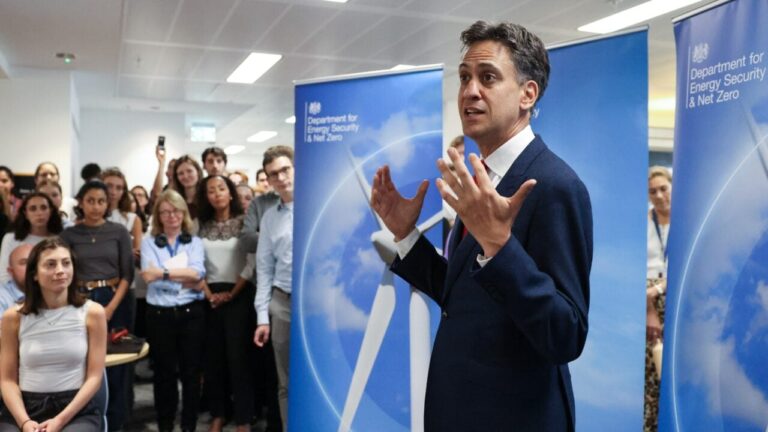Trade association Solar Energy UK (SEUK) says it expects solar energy generation to “significantly exceed” the Clean Power 2030 Action Plan target.
In what the UK government is calling the most ambitious reforms to the country’s energy system in a generation, setting out a plan to achieve clean energy by 2030, the Clean Power Action Plan builds on pathways set out by the National Energy System Operator (NESO).
SEUK criticized NESO’s Clean Power 2030 (CP30) report. It said the plan showed a “worrying lack of ambition” for solar energy, arguing that the report betrays a “limited understanding” of solar power generation and battery energy storage.
The Clean Power Action Plan, set out on Friday (December 13) by Energy Secretary Ed Miliband, sets a target of reaching a solar energy capacity of 45 GW-47 GW by 2030. In response to NESO’s CP30, Solar Energy UK published an analysis showing that the target for solar power generation of 60 GW by 2030 could be achieved by 2030 significantly reduce the cost of electricity.
The government’s Clean Power Action Plan admits there is “room to exceed the 45GW-47GW figure”, “depending on system needs, noting for example the potential of rooftop solar to boost deployment ”.
“The solar industry is consistently exceeding growth expectations, both in the UK and globally, and I have no doubt this will continue to happen for years to come. Aiming for 45 GW is a modest target that we will certainly exceed,” said Chris Hewett, CEO of Solar Energy UK.
Hewett, together with the energy secretary, also leads the UK Solar Taskforce, which will publish its solar roadmap early next year. An important element of this, according to SEUK, is the skills agenda. The trade association will participate in a government-industry forum on the supply chain and workforce, convened by the Clean Power 2030 Unit and the Office of Clean Energy Jobs.
Over the summer, SEUK and the Microgeneration Certification Scheme (MCS) worked together to set up an Installer Training Hub, hosting presentations, tutorials, product demonstrations, question and answer sessions and interactive learning sessions to teach theory and practical skills.
Clean Power 2030 Action Plan calls for reform of the electricity grid
The Clean Power Action Plan notes that the queue for grid connection has grown tenfold in the last five years and contains the equivalent of 739 GW of capacity – many of the projects in the queue are speculative or do not have the financing or planning permission to progress.
SEUK said it “completely” agrees with suggestions that an overhaul of the electricity grid is necessary to meet 2030 clean energy targets. In terms of regional capacity breakdowns, a total of 10.8 GW has been allocated to transmission-connected solar in 2030, of which 36.2 GW is on distribution voltage, which is in line with SEUK recommendations.
NESO’s CP30 projected at least 22.6 GW of battery energy storage by 2030, rising to 27.4 GW in its ‘Further Flex and Renewables’ trajectory, up from 4.7 GW in 2023. The Department for Energy Security and Net Zero (DESNZ ) echoes this, with the Clean Power 2030 Action Plan predicting a dramatic expansion of the battery energy storage sector by 2030.
However, SEUK points out that growth forecasts in the sector are limited by referring only to systems intended to store energy for a short time; no definition of long-term energy storage has yet been made.
A boost for solar energy in the Clean Power Action Plan
Solar Energy UK notes that the plan recognizes the role of solar developments in nature recovery and will respond to the Government’s invitation to submit ideas on encouraging “nature-positive best practice in energy infrastructure development”.
The transition to clean energy has been announced by the current government as a means to reduce energy bills for households and businesses “for good”. This focus on potential energy independence for households could be achieved through solar energy and other forms of micro-generation, SEUK said.
The government plans to expand the renewable energy auction process so projects can get financing before their construction permits are finalized, halting delays and bringing more projects online. As rumoured, ministers have said that the biggest ever Contracts for Difference (CfD) auction for clean energy projects in Britain will take place in 2025.
It is also committed to consumer reforms to help households have more choice and access cheaper energy rates.
For industry body RenewableUK’s director of future electricity systems, Barnaby Wharton, “The Clean Power Action Plan will be seen as a milestone for the clean energy sector.
“Not only do investors have a clear government target to build a lowest-cost electricity system, dominated by wind and solar energy, but they now also have a roadmap to achieve this.”
More coverage of the 2030 Clean Energy Action Plan can be found on our sister site, Current±.


